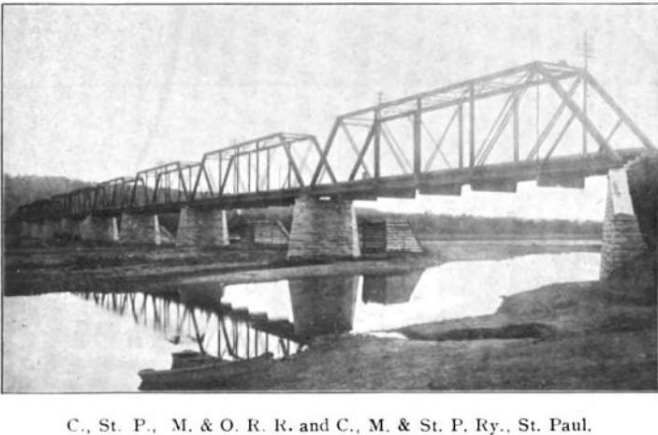- 1865: 22 miles completed from Mendota to Merriam Junction, Minnesota by the Minnesota Valley Railway Company
- 1866: 17 miles completed from Merriam Junction to Belle Plaine, Minnesota by the Minnesota Valley Railway Company
- 1867: 16 miles completed from Belle Plaine to Le Sueur, Minnesota by the Minnesota Valley Railway Company
- 1868: 12 miles completed from Le Sueur to Kasota, Minnesota by the Minnesota Valley Railway Company
- 1869: 5 miles completed from Mendota to St. Paul, Minnesota by the Minnesota Valley Railway Company
- 1869: 22 miles completed from Kasota to Lake Crystal, Minnesota by the Minnesota Valley Railway Company
- 1869: 22 miles completed from Lake Crystal to St. James, Minnesota by the St. Paul and Sioux City Railroad
- 1869: 22 miles completed from Lake Crystal to St. James, Minnesota by the St. Paul and Sioux City Railroad
- 1870: Minnesota Valley Railway purchased by the St. Paul and Sioux City Railroad
- 1871: 58 miles completed from St. James to Worthington, Minnesota by the St. Paul and Sioux City Railroad
- 1872: 64 miles completed from Worthington to Le Mars, Iowa by the St. Paul and Sioux City Railroad
- 1881: StP&SC sold to the Chicago, St. Paul, Minneapolis & Omaha Railway
- 1882: CStPM&O leased by the Chicago & North Western Railway
- 1882: CStPM&O acquired by the Chicago & North Western Railway
- 1995: C&NW purchased by Union Pacific Railroad
- 1995-Present: Union Pacific operates the St. Paul to St. James segment as the Mankato Subdivision
- 1995-Present: Union Pacific operates the St. James to Sioux City segment as the Worthington Subdivision
11/12/21
View an article detailing the construction of this bridge.
Likely the most unique railroad bridge in Saint Paul, this bobtailed swing bridge features a massive concrete counterweight.
Named for being the fifteenth bridge on the Chicago, St. Paul Minneapolis & Omaha Western District, this bridge is the only bobtail swing span to cross the Mississippi River, and one of only a few such spans ever built.
The site of the first railroad crossing of the Mississippi River in St. Paul, the original wooden swing bridge was completed in 1869, and replaced by 1877. In 1885, the original swing bridge was replaced with an iron lattice through truss, built by Lassig Bridge & Iron Works. Lassig did further work in 1887, replacing the original west approach with a 150' Quadrangular Through Truss. Additional work was contracted by the Milwaukee Road the following year, when Keystone Bridge Company replaced the six 150-foot east approach with pin connected Pratt Through Trusses.

Previous bridge, looking west; from the Journal of the Western Society of Engineers. A view of the swing span and west approach can be seen here.
In 1915, that bridge was replaced with the current bridge, which was jointly designed by C.F. Loweth of the Milwaukee Road and H. Rettinghouse of the Omaha Road. A massive riveted warren Through Truss has a large counterweight on one end was constructed, and several spans of deck plate girder to approach. The entire bridge was set on concrete substructures, which did not reuse the original stone piers. It is unknown for sure what happened to the old spans, but it is believed that the stationary spans may have been reused.
The construction of the current bridge was a complicated affair, involving numerous contractors, two chief engineers and the requirement to keep traffic moving at all times. The link above details the construction process in a very excellent manner. As part of the construction, 48,000 cubic yards of earth were moved from the river bed, with LaCrosse Dredging Company of Minneapolis completing the work. The bridge was completed under J.D. Moen, with I.F. Stern used as a consulting engineer and T.E. Van Meter as the assistant engineer.

Blueprint showing the current bridge and old bridge
Today, this bridge has had very little alteration and retains a great historical integrity. It is believed that the Milwaukee Road, who jointly owned this bridge, supplied the engineering for this structure. Of the few railroad bridges utilizing a bobtail swing design, almost all of them were along the Milwaukee Road system.
Overall, the bridge appears to remain in fair to good condition.
The author has ranked this span as being regionally significant, due to the bobtail design.
The photo above is an overview.
| Upstream | Short Line Bridge |
| Downstream | Robert Street Lift Bridge |
